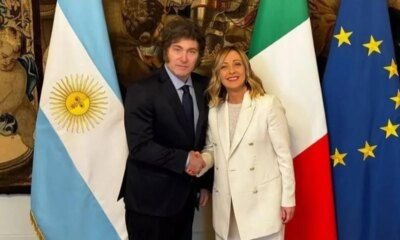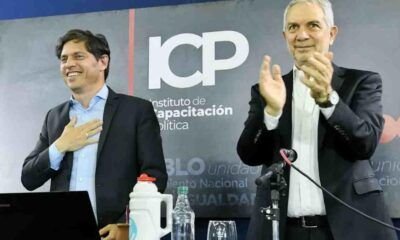INTERNACIONAL
Un nuevo artefacto permitirá identificar planetas escondidos: cómo funciona

A lo largo de la historia, la astronomía se ha dedicado a buscar nuevas formas de vida por fuera de la Tierra con distintos mecanismos, además de innumerables estudios para hallar cuerpos que aún no han sido reconocidos en el espacio. Ahora, un grupo de investigadores de la Universidad de Arizona creó un innovador coronógrafo, un artefacto que permitiría encontrar planetas ocultos que son invisibles para un telescopio común y corriente.
En simples palabras, este aparato logra bloquear la luz que irradia un objeto para poder ver otro que se encuentre atrás o más alejado, y que se encuentra tapado por la iluminación. En este caso, el estudio realizado por Nico Deshler agregó innovaciones para que pueda ayudar a la ciencia a descubrir la existencia de exoplanetas.
La Universidad de Arizona realizó una investigación, con Nico Deshler a la cabeza, que resultó en la creación de un nuevo coronógrafo que logra revelar la existencia de exoplanetas que son tan pequeños que se encuentran tapados por la luz de las estrellas que están cerca o por encima.
En conversación con la revista especializada llamada Optica, el jefe de este estudio explicó las razones de su creación y comentó que “los planetas similares a la Tierra en la zona habitable —la región alrededor de una estrella donde las temperaturas podrían permitir la existencia de agua líquida— pueden ser fácilmente hasta mil millones de veces más tenues que su estrella anfitriona”.

“Esto los hace difíciles de detectar porque su luz tenue queda opacada por el brillo de la estrella. Nuestro nuevo diseño de coronógrafo desvía la luz de la estrella que podría oscurecer la luz del exoplaneta antes de capturar una imagen”, comentó sobre las cualidades de su artefacto.
Además, Deshler diferenció su descubrimiento y explicó que “en comparación con otros diseños de coronógrafos, el nuestro promete proporcionar más información sobre los llamados exoplanetas subdifractivos, aquellos que se encuentran por debajo de los límites de resolución del telescopio. Esto podría permitirnos detectar potencialmente biofirmas y descubrir la presencia de vida entre las estrellas”.
Si bien el coronógrafo es un artefacto que inventó en el 1931 el científico Bernard Lyot, el creado por Nico Deshler en la Universidad de Arizona tiene algunas diferencias que lo hacen aún más útil para la detección de exoplanetas:
Mecanismo de eliminación de luz
- Coronógrafo tradicional: estos bloquean la luz proveniente de una estrella central mediante un disco oscuro o una máscara. Si bien son útiles para disminuir la luz de la estrella y mejorar la visibilidad de los exoplanetas cercanos a ella, tienen limitaciones cuando se trata de planetas que se encuentran muy cerca de la fuente lumínica, o cuando hay grandes diferencias de brillo
- Coronógrafo de Nico Deshler: utiliza una técnica avanzada de filtrado espacial, el cual funciona con un “ordenador de modos espaciales” para separar y eliminar la luz de la estrella basándose en patrones únicos de oscilación de luz, como si fueran diferentes frecuencias acústicas en un piano. Así, crea una imagen del exoplaneta de manera más precisa y permite detectar planetas aún cuando se encuentran por debajo del límite de resolución del telescopio

Capacidad de resolver exoplanetas cercanos
- Coronógrafo tradicional: tiene dificultades para detectar exoplanetas muy cercanos a su estrella, ya que no puede superar los límites de resolución del telescopio, especialmente si el contraste es demasiado grande
- Coronógrafo de Nico Deshler: puede detectar planetas sub-difracción, es decir, planetas cuya distancia a la estrella es tan pequeña que no podrían ser resueltos por un telescopio convencional
Captura de imágenes del exoplaneta
- Coronógrafo tradicional: se limita a medir la cantidad de luz que emite un exoplaneta sin proporcionar una imagen detallada de su posición o contexto en relación con la estrella
- Coronógrafo de Nico Deshler: genera imágenes completas, lo que proporciona un contexto visual y más información sobre la órbita y otros elementos como el polvo disperso cerca de la estrella.
INTERNACIONAL
Dramático llamado en el inicio de la Cumbre de los Océanos: los mares no deben convertirse en el «far west»

Groenlandia no está en venta
Los objetivos de la cumbre
Las palabras de Antonio Guterres
Una conferencia global
INTERNACIONAL
‘Homeland would’ve been stolen’: AK Natives sound off on Biden energy bans as Trump officials tour tundra

NEWYou can now listen to Fox News articles!
FIRST ON FOX: Alaska Natives and residents of the vast North Slope Borough communities along the Arctic Ocean got a rare chance this week to directly discuss their concerns with White House officials, typically 3,500 miles away in Washington.
Interior Secretary Doug Burgum, Energy Secretary Chris Wright and EPA Administrator Lee Zeldin joined Alaska Gov. Mike Dunleavy and local residents in Utqiagvik (formerly Barrow) as part of a multi-day visit to the oil and gas fields, workers and neighbors in the frigid but crucial region.
Charles Lampe, a Native resident of Kaktovik – the main remote community within the Arctic National Wildlife Refuge (ANWR) a few hundred miles eastward – said until President Donald Trump and the officials assembled in Utqiagvik took office, North Slope residents and their energy development hopes felt besieged by that same far-flung federal government.
Lampe voiced similar concerns to those Fox News Digital had been told in the past by Alaska officials, in that environmental activists in the Lower 48 and federal officials who ideologically align with them have tried speaking for them in opposition to developing ANWR and other sites where none of those same activists live.
ALASKA SENATOR LITERALLY TEARS UP BIDEN’S ENERGY ORDERS, BOOSTS WH EFFORTS TO LEVERAGE ARCTIC LNG IN ASIA TRADE
State and federal officials visit the North Slope Borough. (US Dept of Energy & US Dept of Interior)
«There’s one thing that I want to bring up – we were under attack in Kaktovik by environmental groups,» Lampe said.
«On Day 1, President Trump told the Fish and Wildlife Department to deny their requests. And that was such an amazing thing for us to be able to see. And we were so proud of our president then because he made sure that our ancestral homelands weren’t going to be stolen – and [instead] protected,» Lampe said, as many in the North Slope actually support the development of their Native homelands versus cordoning them off through regulation – as they bring jobs and resources.
AK CAN BE ‘CURE TO THE NATION’S ILLS’ WITH HELP FROM TRUMP ADMIN: GOV DUNLEAVY
«So I really need to bring back this immense gratitude to President Trump for that action and being able to write something that, if the other guy (Joe Biden and Kamala Harris) would have won, there’s no doubt in my mind that our homeland would have been stolen and there’s nothing we could have done about it,» he said.
«Trump had the heart and the wherewithal to be able to right this wrong.»
He told Burgum to invite Trump to Kaktovik to see ANWR and its «Section 1002» – the oil and gas development sector – for himself.
Burgum said he believes Trump would be open to the opportunity – and that the president has already pleasantly surprised regional corporate stakeholders with his openness to questions that the oil companies felt loath to even consider asking a president.
AK LAWMAKERS CLAIM VICTOR AS FEDS BEGIN REVERSAL OF ‘ILLEGAL’ BIDEN RULE RESTRICTING ANWR OIL, GAS
«President Trump does care super deeply about this and at a deep level,» Burgum said, adding the president shocked ConocoPhillips representatives in a recent meeting when he asked what they needed to improve their North Slope operations.
When the company noted improved roads would be helpful, Trump asked rhetorically why a road couldn’t be built, according to Burgum.
«[They] were kind of like, ‘Wow, I didn’t know we could ask that.’»
Wright also addressed the Utqiagvik meeting, and added in separate comments that he visited the Prudhoe Bay Discovery Well – a 1960s operation that first opened Alaska to energy development and at one point represented one-quarter of U.S. oil output.
«Unfortunately, the last few decades have seen a long, slow decline of North Slope oil production – not because they’re running out of oil. In fact, there’s an amazing amount of untapped, unproduced oil up here. It’s because of federal regulation, bureaucracy. It’s made it so expensive and difficult to operate,» Wright said.
He added that with the «Big, Beautiful, Twin Natural Gas Pipeline» ultimately constructed, Alaska could be the key to global energy security by drawing buyers in Korea and Japan away from China.
«It’s great to be part of history again here in the great North Slope oil fields of Alaska,» Wright said.
Dunleavy last week headlined a global sustainable energy conference in Anchorage, which also drew the attention of those same potential stakeholders from Asia.
INTERNACIONAL
Temor entre los hinchas por posibles redadas migratorias durante el Mundial 2026

Manny Mizael cambió Brasil por Boston hace 27 años, pero su pasión por un equipo de fútbol a casi 8000 kilómetros de distancia, en Río de Janeiro, arde con más fuerza que nunca.
Tanto es así que Mizael ayuda a dirigir un club de aficionados en Massachusetts para el equipo, el Flamengo, uno de los más populares de Brasil. Su grupo organiza regularmente proyecciones de partidos que atraen a cientos de seguidores.
Leé también: El inocente hábito de ir al baño sin ganas que puede dañar la salud: los motivos
Pero este año, los grupos de WhatsApp de los aficionados empezaron a encenderse con charlas sobre la represión de la inmigración por parte del gobierno del presidente Donald Trump casi tanto como sobre las victorias más recientes del Flamengo. Los temores eran tan intensos que el grupo suspendió una fiesta para ver un partido en febrero, dijo Mizael, por temor a convertirse en el objetivo de una redada de inmigración. Muchos de los seguidores no son originarios de Estados Unidos y carecen de estatus legal.
“Están agarrando a la gente en la calle y deteniéndola”, dijo Mizael. “Decidimos no hacer el partido porque pensamos que podría arruinar la vida de mucha gente”.
Las políticas de Trump y el fútbol
La cancelación fue un adelanto de cómo las políticas de inmigración del presidente Trump se perfilan para afectar al Mundial del próximo año, el acontecimiento deportivo más visto. Se espera que atraiga a unos 6,5 millones de personas, muchos a Estados Unidos, donde se disputarán la mayoría de los partidos. (Canadá y México son coanfitriones del torneo). Los aficionados suelen hacer todo lo posible para viajar una vez en la vida a la Copa, y gastan años de ahorros o posponen compras importantes, como vivienda, para pagar el viaje.
Donald Trump y Gianni Infantino en la Casa Blanca. Washington, D.C., 6 de mayo de 2025. REUTERS/Kent Nishimura
Para algunos, la posibilidad de ese viaje ya podría estar condenada. Los tiempos de espera para obtener una visa para varios países —entre ellos Colombia, cuyos seguidores suelen asistir en gran cantidad a los Mundiales— se extienden más allá del torneo del próximo verano. Irán, el primer equipo de Asia clasificado para el Mundial, está en la lista de 12 países a los que Trump prohibió la entrada. Hizo una excepción para los atletas y el personal de la Copa y otros acontecimientos deportivos, pero no para los hinchas.
En los últimos torneos celebrados en Rusia y Qatar, los países anfitriones y la FIFA acordaron un programa de exención de visados para la mayoría de las personas que tuvieran entradas. No se ha establecido nada similar para el próximo verano.
Las duras políticas de inmigración del gobierno de Trump también han afectado a la contratación de personal para la Copa, según dos personas con conocimiento directo del asunto. La FIFA suele emplear a contratistas con experiencia en grandes acontecimientos complejos, como los Juegos Olímpicos, para que ayuden a organizar el torneo. Para la Copa de 2026, ese proceso ha resultado más difícil de lo habitual, incluso el gobierno ha rechazado algunas solicitudes de visado y ha preguntado por qué la FIFA no puede contratar a estadounidenses para el trabajo, según un funcionario del fútbol informado sobre la planificación.
Un portavoz de la FIFA negó que el proceso para obtener visas de trabajo hubiera sido difícil y señaló que la organización contaba con una plantilla de 800 personas en Miami y tenía previsto enviar personal de Europa para ayudar. El portavoz declinó hacer comentarios sobre la posibilidad de que se impidiera a los aficionados de determinados países asistir a la Copa Mundial o sobre los esfuerzos que estaba realizando la FIFA para garantizar que quienes tengan entradas pudieran asistir.
El Departamento de Seguridad Nacional tampoco quiso hacer comentarios.
La FIFA, EE.UU. y el Mundial de Clubes
La FIFA también está organizando un torneo de mil millones de dólares y un mes de duración, que comenzará la semana que viene, llamado Mundial de Clubes, que llevará a Estados Unidos a 32 equipos de clubes, entre ellos el Flamengo. El torneo, el primero de este tipo, es un precursor de la Copa Mundial del próximo verano.
Para el grupo de Mizael, los acontecimientos relacionados con la inmigración han estropeado los planes de lo que habría sido un festival de fútbol en las próximas semanas.
Se descartaron las fiestas para ver los partidos, así como las conversaciones sobre viajar en grupo a partidos en Filadelfia y Orlando, por temor a que un autobús de migrantes se convirtiera en objetivo. “Eso es algo que no podemos tener en nuestra conciencia”, dijo Mizael.
Quedan miles de asientos sin vender para el torneo de clubes, y los funcionarios de la FIFA atribuyen al menos parte de la escasez a la preocupación de los aficionados por la situación de sus visados, según el funcionario de fútbol y otro funcionario.
Las ventas han sido tan escasas que la FIFA ha bajado los precios en repetidas ocasiones. Los precios en las plataformas de reventa están bajando para el partido inaugural, en el que juega el Inter de Miami, un equipo que agotó las entradas en los estadios de todo el país el año pasado, cuando Lionel Messi se incorporó a su plantilla. Otros factores de la aparente falta de interés son la ausencia de algunos de los equipos más importantes de Europa, los precios iniciales de las entradas y la incertidumbre sobre un nuevo torneo.
El vocero de la FIFA negó que la venta de entradas fuera “baja” para los aficionados radicados en Estados Unidos, pero no facilitó cifras totales de ventas. Dijo que habían comprado entradas aficionados de más de 130 países.
La Casa Blanca ha mostrado un gran interés por la Copa del año que viene. Trump creó un grupo de trabajo que él mismo preside, y el presidente de la FIFA, Gianni Infantino, apareció en el Despacho Oval, donde el enorme trofeo dorado del torneo de clubes estuvo expuesto durante semanas.
Leé también: Cómo investigar y planificar unas vacaciones desde tu teléfono
En una reunión del grupo de trabajo celebrada el mes pasado, el vicepresidente JD Vance dijo que los aficionados podían esperar una “experiencia sin contratiempos” al visitar Estados Unidos y anticipó la llegada de visitantes de unos 100 países.
Sin embargo, también les advirtió de que no se quedaran más tiempo de la cuenta. “Cuando se acabe el tiempo”, dijo, “tendrán que volver a casa”.
(*) Tariq Panja es corresponsal deportivo mundial y se centra en historias en las que el dinero, la geopolítica y el crimen se cruzan con el mundo del deporte.
Mundial 2026, Migraciones, deportación
-

 POLITICA2 días ago
POLITICA2 días agoCristina Kirchner advirtió que la pueden “meter presa” y lo relacionó con su candidatura a diputada provincial
-

 ECONOMIA3 días ago
ECONOMIA3 días agoUn proyecto de u$s100.000 millones: claves del acuerdo entre Milei y Meloni para exportar gas de Vaca Muerta
-

 POLITICA2 días ago
POLITICA2 días agoTras la muerte de Thiago, Patricia Bullrich redobló su defensa del policía y pidió perpetua para los tres ladrones



















